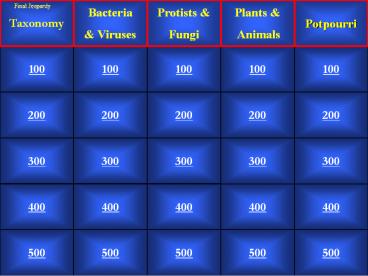Taxonomy - PowerPoint PPT Presentation
1 / 56
Title:
Taxonomy
Description:
Title: PowerPoint Presentation Author: M. Altermann Last modified by: Michelle Created Date: 9/24/2003 10:36:21 PM Document presentation format: On-screen Show (4:3) – PowerPoint PPT presentation
Number of Views:122
Avg rating:3.0/5.0
Title: Taxonomy
1
Taxonomy
Bacteria Viruses
Protists Fungi
Plants Animals
Potpourri
Final Jeopardy
100
100
100
100
100
200
200
200
200
200
300
300
300
300
300
400
400
400
400
400
500
500
500
500
500
2
Binomial nomenclature
3
What is a two name naming system, or What are
genus and species?
4
Morphology or appearance but not form or function
5
What are criteria for developing a dichotomous
key?
6
Linneaus
7
Who was the father of modern taxonomy?
8
Phylogeny or phylogenic tree
9
What is a structure that shows divergence from a
common ancestor using time and/or a specific
characteristic?
10
The levels of classification in order from most
inclusive to least inclusive
11
What are Kingdom, phylum, order, class, family,
genus and species?
12
The living member of this category
13
What are bacteria?
14
Viral structures
15
What are capsid (or protein coat) and nucleic
acid?
16
Peptidoglycan
17
Cabohydates found in the cell walls of bacteria?
18
The three main bacterial shapes
19
What are cocci, bacilli and spirilli (or
spirochetes)?
20
Identify these
21
What are
- A- flagellum
- B cytoplasm
- C chromosome
- D pilus
- E capsule
- F cell wall
- G cell membrane
- H plasmid
22
The three groups of protists
23
What are plant like, animal like and fungi like?
24
The 4 types of movement that classify the animal
like protists
25
What is locomotion by flagella, cilia,
pseudopods or spores?
26
Also known as diatoms
27
What are the Chrysophyta, or golden brown algae?
28
Symbiotic relationship formed between a fungus
and a plant
29
What are mychorrhizae?
30
Identify these
31
What are
- A cap
- B gills
- C spores
- D annulus
- E stalk
- F hyphae
- G mycellium
32
Found only in gymnosperms and angiosperms
33
What are seeds?
34
The major groups of plants
35
What are green algae, mosses, ferns, gymnosperms
and angiosperms?
36
The phylum characterized by this organism
37
What is Annelida?
38
This type of symmetry
39
What is radial symmetry?
40
Any five of the 9 major animal phyla covered in
class
41
What are
- Porifera (Sponges)
- Cnidarians
- Platyhelminthes (Flatworms)
- Nematoda (Roundworms)
- Annelida
- Mollusca
- Arthopoda (insects)
- Echinoderms
- Chordates
42
A gametophyte
43
What is a haploid organism?
44
The most closely related organisms
Common Name Genus/Species Family
Red squirrel Tamiasciurus hudsonicus Sciruidae
Shorttail weasel Mustela ermine Mustelidae
Ground hog Marmot monax Sciruidae
Mink Mustela vison Mustelidae
Eastern chipmunk Tamias striatus Sciruidae
River otter Lutra canadensis Mustelidae
Fisher Martes pennant Mustelidae
Muskrat Ondatra zibethica Cricetidae
Black-footed ferret Mustela nigripes Mustelidae
45
What are the mink, short tail weasel and ferret?
46
The levels of biodiversity
47
What are genetic diversity, species diversity and
ecosystem diversity?
48
The reasons for the mysterious disappearance of
honeybees
49
What are mites, viruses, pesticides, or other
human activities?
50
The six characteristics that all animals share
51
What are
- Eukaryotic
- Lack cell walls
- Multicellular
- Heterotophs
- Motile at some time
- Form a blastula
52
Final Jeopardy!
53
The Final Jeopardy Category is Reproduction
54
Alternation of generations
55
What is a life cycle that alternates between a
haploid or gametophyte form and a diploid or
sporophyte form?
56
Good Luck on your test!































